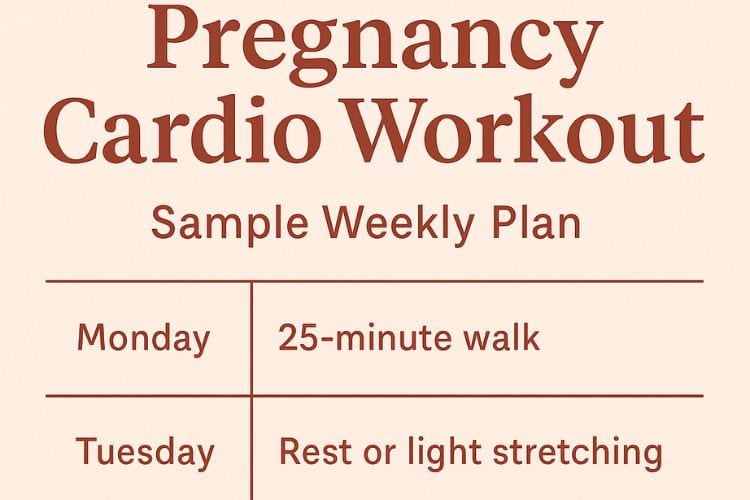Sign up for workout ideas, training advice, reviews of the latest gear and more.






Staying active during pregnancy is one of the best gifts you can give to yourself and your growing baby. Exercise, particularly cardiovascular workouts, supports heart health, boosts energy, and reduces common pregnancy discomforts like back pain and swelling. While pregnancy changes how you move and train, cardio remains safe and highly beneficial when done correctly. This guide will walk you through the benefits of pregnancy cardio workouts, safety guidelines, and structured routines that are ideal for expectant mothers.
Cardio exercise strengthens the cardiovascular system, ensuring efficient blood flow to both the mother and the baby. Improved circulation reduces swelling in the ankles and feet and helps prevent pregnancy-related hypertension.
Pregnancy can leave women feeling tired. Light to moderate cardio workouts increase oxygen flow and endorphins, which fight fatigue and boost mood.
Gaining weight is normal during pregnancy, but cardio helps maintain it within healthy ranges. This reduces risks of complications like gestational diabetes and makes postpartum recovery smoother.
Cardio improves stamina and breathing control, both of which are valuable during labor and delivery. It also strengthens core and pelvic floor muscles that play an essential role in childbirth.
Before beginning or continuing a cardio workout routine, always get clearance from your doctor or midwife. Every pregnancy is unique, and what’s safe for one person may not be for another.
Drink plenty of water before, during, and after workouts. Overheating can be harmful, especially in the first trimester. Choose well-ventilated spaces or indoor environments.
Skip activities that involve jumping, sudden direction changes, or high fall risk. Contact sports, heavy lifting beyond your comfort, and exercises lying flat on your back after the first trimester should be avoided.
Walking is the simplest and safest cardio workout. It is low-impact, requires no equipment, and can be adjusted in pace and duration depending on energy levels. Aim for 20–40 minutes daily.
Cycling indoors is joint-friendly and safe since it eliminates the risk of falling. Adjust the seat height and resistance to ensure comfort.
Water supports body weight, making swimming an excellent cardio option that reduces pressure on the joints and helps relieve swelling.
Specialized prenatal aerobics classes combine gentle cardio with flexibility and balance training. They are effective and social, which boosts motivation.
Slow to moderate dance workouts improve circulation and coordination. Stick to pregnancy-friendly variations without jumps or rapid turns.
Ellipticals provide a smooth cardio option with minimal impact on joints. Adjust resistance for a safe challenge.
Focus: Building a consistent routine and adjusting as energy levels fluctuate.
Focus: Supporting endurance while accommodating a growing belly.
Focus: Prioritizing comfort, relaxation, and circulation to prepare for labor.
Cardio increases maternal oxygen levels, improving oxygen delivery to the baby.
Studies show regular cardio exercise lowers the risk of low birth weight and supports overall fetal development.
Regular movement lowers risks of gestational diabetes and preeclampsia, promoting a healthier pregnancy outcome.
Exercise releases endorphins, which stabilize mood and lower stress levels—a common challenge during pregnancy.
Many pregnant women struggle with disrupted sleep. Gentle cardio helps regulate sleep patterns and enhances rest quality.
As the body changes, exercise helps maintain strength and mobility, which can enhance self-esteem and confidence.
If you feel dizzy, short of breath, or experience pain, stop immediately and rest.
Invest in a good pair of supportive sneakers and maternity-friendly workout wear to stay comfortable.
Always include 5 minutes of warm-up and cool-down stretches to prevent strain.
Vary your cardio activities—alternate between walking, swimming, and cycling to keep workouts fun and sustainable.
Running can be safe if you were a runner before pregnancy and your doctor clears it. Always keep intensity moderate and avoid overheating.
Most guidelines recommend 150 minutes of moderate-intensity cardio per week, spread across 4–6 sessions.
Gentle cardio like walking often helps ease nausea by improving circulation and endorphin release.
Yes, but begin with low-intensity options such as walking or swimming, and gradually increase duration.
Pregnancy is a transformative time, and staying active through cardio exercise is one of the most effective ways to support your health and your baby’s development. With proper safety measures and trimester-specific adjustments, cardio workouts can reduce discomfort, improve mood, and prepare your body for labor. Whether you prefer walking, swimming, or prenatal dance, consistency matters more than intensity.
Cardio during pregnancy is not about pushing limits—it’s about moving with care, intention, and joy. By committing to regular cardio, you’ll not only make pregnancy smoother but also set a strong foundation for postpartum recovery and long-term wellness.
Stay up to date on the latest women’s health, fitness and lifestyle trends and tips.